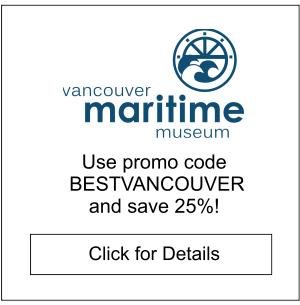Seabreeze Adventures, Vancouver Whale Watch, Prince of Whales and Wild Whales Vancouver are tour companies that offer whale watching excursions.
The largest of the four companies is probably Prince of Whales. It operates in both Vancouver and Victoria. It gets near perfect reviews! The other companies are good too though.
This article contains information about the following topics:
Prices & Options | Whale Watching Companies | Prince of Whales | Vancouver Whale Watch | Seabreeze Adventures | Wild Whales Vancouver | White Rock Sea Tours | How Do You Choose | Things to Know | Tips & Advice | Other Information
Click any of the above links to jump to a specific topic, or continue reading to learn all about whale watching opportunities in Metro Vancouver.
(Note: Information in this article is accurate to the best of our knowledge at the time of writing. Details may vary and are subject to change.)
Whale Watching in Vancouver
Going out on a boat and seeing orcas and other whales in their natural habitat can be pretty amazing. That’s why whale watching excursions are so popular in Vancouver.
There are a number of whale watching companies in the Lower Mainland. Some are based out of the City of Vancouver and leave from places like Coal Harbour and Granville Island. Others depart from docks at Richmond’s Steveston Village and in White Rock.
Whale Watching Prices and Options
Prices for whale watching excursions can vary, as can what you get from the service.
Whale watching tours typically range in price from about $130 to over $300 for adults. Children under age 4 or 5 are usually free, but not always.
Prices depend a bit on the comfort-level, size and age of the boat, as well as the distance travelled, duration of the voyage and destinations of the trip.
In most cases, you get what you pay for, but it can also depend on where you start from and the amount of nearby competition. That being said, assuming good weather and whales to see, the overall experience with most outfits is generally fairly comparable and equally enjoyable.
Most whale watching trips take only four or so hours, but there are a few that go all day. Some vessels are large and others are small.
With many of the tours, you are exposed to the elements, but with a few you are primarily inside the vessel. Some boats are modern, have comfy seating and first-class service. Other vessels are older and more basic. Some tours offer extensive commentary, and others just a little. The range of options is extensive!
Even within the same company, the types of boats and level of service can vary considerably. Prince of Whales, for example, has vessels ranging from relatively small inflatable-style Zodiac boats, (for shorter distance tours) up to massive almost mini-cruise-ship-style vessels that go much further out to sea.

Whale Watching Companies
Below is information about some of Metro Vancouver’s main whale watching companies.
Note: Company and excursion details are subject to change. See official websites for the most up-to-date information, or online review websites to learn about recent traveller experiences.
Prince of Whales
With over 12 vessels in both Vancouver and Victoria, Prince of Whales is one of BC’s largest and best-known whale watching companies. The company has a large fleet of boats, of varying shapes and sizes. Prince of Whales offers half-day excursions starting at about $199 and full-day trips to Victoria for $599, among other options. Prince of Whales also has non-whale watching sightseeing tours that start at about $79.
The half-day whale-watching trips run from March until November, last for between three and five hours, and take place on semi-covered vessels. Free tea and coffee are usually provided. Other snacks and beverages can be purchased onboard.
Prince of Whales used to be based at the Westin Bayshore Hotel in Coal Harbour. More recently, however, its home is now on Granville Island. Similar to most other whale watching companies, if there are no whales on your trip you can go again on another day for free (although some restrictions apply).
As of January 2024, Prince of Whales has a 4.5 Star rating on Yelp and a 5 Star rating on Tripadvisor.
See our article about the Prince of Whales for more information about this company.

Vancouver Whale Watch
Although having the word “Vancouver” in its name, Vancouver Whale Watch is actually a Richmond-based company. It offers three- to five-hour trips from Steveston Village between early April and end of October.
Vancouver Whale Watch operates a small number of Zodiac boats. The Explorathor II is an open 47-passenger vessel and the Express is a semi-covered 45-passenger boat. The company also has a couple of smaller 12-passenger open-air Zodiacs.
Vancouver Whale Watch boasts a 90+% whale-sighting success rate, and its come-again-if-there-aren’t-any-whales guarantee has no expiry date, which is great.
Rates as of early 2024 are between $179 and $189 for adults, plus GST taxes. Complimentary beverages and snacks are sometimes available and whale-watching suits, hats and gloves are included for travellers on the open-air vessels. Conveniently, there is a shuttle service from a variety of Vancouver hotels at a cost of around $20 round trip.
As of January 2024, Vancouver Whale Watch has a 4 Star rating on Yelp.
Click Vancouver Whale Watch for more information.
Seabreeze Adventures
Seabreeze Adventures is another whale watching operation based out of Steveston Village in Richmond. Its standard trips last for between three and five hours and it too boasts a 90+% whale-sighting success rate.
Seabreeze Adventures also offers a good whale-watching guarantee. If you are on one of the five percent to 10% of trips that don’t encounter at least one whale, you can go again for free as many times as needed until you see a whale. The “come-again” pass never expires, but, the same as with other companies, it can only be used by the original passenger, which is only reasonable.
Whale watching excursions with Seabreeze Adventures cost $164 per adult (plus taxes). The company’s main boats are semi-enclosed and hold up to 23 passengers. For the last couple of years Seabreeze Adventures has also operated a smaller open-air 12-passenger Zodiac.
The company has a 4 Star rating on Yelp. Tripadvisor, meanwhile, gives it 4.5 Stars (which is likely more accurate given the higher number of reviews).
See the Sea Breeze Adventures website for more information.

Wild Whales Vancouver
Wild Whales Vancouver is a whale watching company that offers tours based out of Granville Island. The outfit has been running for more than 12 years and operates about three boats.
The Jing Yu is a 42-foot 32-passenger catamaran with an outer deck and indoor cabin. It is the only boat in the fleet where passengers are not provided (or need) special weather-proof whale-watching outfits.
The Eagle Eyes is a 43-foot 35-person boat, while the Aurora I and Aurora II zodiac boats are much smaller and only recommended for those over 9 years old.
As of January 2024, Wild Whales Vancouver has a 4.5 Star rating on both Yelp and Tripadvisor.
Trips with Wild Whales Vancouver cost around $170 (plus tax) for adults and last for between three and five hours depending on how far the boat needs to travel to find the whales on any given day.
Similar to other whale-watching companies, if there are no whales on your trip you are welcome to book a second trip at a time of your convenience (and hopefully you’ll have better luck then).
For more information see the Wild Whales Vancouver website.

White Rock Sea Tours
White Rock Sea Tours offers whale-watching excursions from the resort town of White Rock (which is located just south of Surrey). The company’s Whale Watching Adventure Trips start at $175 and last for between three and five hours.
Passengers on the vessels wear special floatation suits which come in sizes from extra-small to triple-extra-large. People are encouraged to bring their own warm hats, gloves and layered clothing as it can get cold out on the water.
The company’s fleet consists of smaller open-air Zodiac-style boats that carry up to about 12 passengers each. Trips go from White Rock into the Strait of Georgia and to the Gulf Islands and San Juan Islands.
With White Rock Sea Tours, if you don’t see any whales, other marine mammals and beautiful scenery you are welcome to come back and try again for free another day.
Note: Parking by the water in White Rock during the summer season (from March to October) costs $4.50 per hour (as of January, 2024) and is restricted to a maximum of four hours, which isn’t convenient when taking a boat trip for up to five hours. Parking up the hill in town, though is free and taxis are available to get there and back.
As of January 2024, White Rock Sea Tours has an average rating of 5 Stars on Tripadvisor.
See the White Rock Sea Tours website for further details.
How do you Choose a Whale Watching Company?
It can be hard to choose which whale-watching company is the best. Questions to ask yourself are the following:
- How long is the tour and how much time do you want to spend out on the water?
- How convenient is the start and finish location to where you are or want to be?
- Do you just want to see some whales or is the scenery and boat ride just as important?
- Do you want lots of commentary, or is just a little okay?
- Is money an issue? Is it worth paying more for a slightly comfier experience?
- Do you want to have to wear a special suit or lifejacket the whole time, or need your own warm clothing, windproof jacket, hat and gloves?
- Do you want to sit mostly inside the vessel, completely outdoors or have the option of both?
Answers to the above questions can help you decide which company, type of boat and starting location is best for you. They’ll also give you ideas for questions to ask when making your reservations or phone inquiries.

Things You Should Know
Below are a number of good things to know about what to expect during your whale watching adventures.
Peak season is in the summer
Whale watching groups usually operate between around April or May and September or October, with peak season for both tourists and whales in June, July and August.
You can see different kinds of whales at different times
Orcas are also known as killer whales. They are black and white, swim in packs, are carnivores (meat eaters), and attack sea lions and other larger marine life. Peak season for killer whales is between June and August, but resident orcas can be spotted throughout the year.
Giant Humpback Whales and Grey Whales are rarer, but also sometimes spotted, especially outside the core summer months. These mammals eat tiny crustaceans, plankton, amphipods and tiny fish. Transient orcas are also sometimes seen, and sea lions, seals and even porpoises are fairly common. Minke whales are also in the area at various times.
Most whale watching companies offer a guarantee
They promise that there will be at least one whale, or that if there isn’t you are allowed to go again another day for free. So you get to go a second time – you don’t get a refund. It’s disappointing to pay money for a whale watching tour and then not see any whales, so make sure your tour operator guarantees you’ll see one.
You have a good chance of seeing a whale
There are whales to be seen about 90% of the time with most companies, but occasionally there aren’t any. Sometimes you might catch just a tiny glimpse of a whale in the distance, other times you might see several, and occasionally you’ll see them relatively close and breaching. It’s the luck of the draw!
Whale-watching companies sometimes cancel trips at the last minute
This can be due to poor weather or low passenger numbers. Be prepared for this, and note that this can be a good reason to book your whale watching excursion near the start of your holiday to allow time to reschedule. Also, if the cancellation is due to weather, be happy – bumpy rides are no fun and whales are hard to see in choppy waters.
Actual whale-watching time can be short
When a company says its trips last for between three and five hours, it’s often on the shorter side when there are whales and longer when there are not (as the operators spend extra time travelling to find the marine life). Also, a four-hour excursion usually means 90 or so minutes of travel time to get to the whales, up to 30 minutes or so of actual whale watching, and then another 90 minutes of travel time back to port.
Boats cannot stay near whales long
Whale-watching vessels are restricted to spending up to one hour maximum within the vicinity of any one group of whales, or just 30 minutes when there are already 10 or more other boats in the area. So don’t be disappointed that you have to move along after finding them.
There are lots of whale-watching companies
In fact, in the busy season, it’s not uncommon for there to be more boats watching than there are whales. Consequently, don’t expect the scene to be just you, your boat, and unobstructed views of the whales. It can get crowded out there, especially on days with few whales in the area.
Boats aren’t allowed to get really close to the whales
Vessels of any kind, including even kayaks, cannot approach closer than 100 metres to most whales, and not within 200 metres of killer whales. One hundred to 200 metres (or yards) is near enough to get a good view, but still far enough away to not disturb or pose a danger to the marine life.
Complaints about whale watching companies are usually fairly similar
When looking at reviews for whale watching outfits on sites like Yelp or Tripadvisor you’ll notice that negative reviews are generally by people who didn’t see any whales. Other common complaints involve last-minute cancellations, bumpy rides in choppy waters or boats not getting closer to the whales. The weather and presence of marine life make a huge difference on a passenger’s experience.

Tips & Advice
Below is some additional information, as well as tips and suggestions to help you make the most of your whale watching experience. The first set of tips includes things to keep in mind prior to your trip.
Pre-Trip Advice
TIP #1: Go on a sunny day. Whale watching can be fun any non-rainy day with calm water, but the experience and views are especially enjoyable on days with sunshine and blue skies.
TIP #2: Go on day with little or no wind in the forecast if you can. If there is a wind, and the water gets even a little bit choppy, it can be difficult to see the whales. In calm waters the mammals are much more visible as their bodies and dorsal fins don’t blend in with the waves.
TIP #3: Don’t forget your camera, and take a zoom lens if you have one because the whales won’t be closer than between 100 and 200 metres away. Also, hang onto your phone or camera equipment extra tight when at the edge of the boat.
TIP #4: Take warm clothes as it can get cold out on the water, and you might want a hat and sunscreen if it’s sunny. A windbreaker can also be good to wear.
TIP #5: It can get windy on the outer decks of boats, and often there can be some ocean spray. Be careful not to get your camera or phone wet. Salt water isn’t particularly good for photographic equipment.
TIP #6: Confirm with your tour operator if (1) seeing a whale is guaranteed; (2) whether the vessel’s main passenger area is indoors or outdoors; (3) if they provide special whale-watching clothing; (4) if you need to take or wear anything special; (5) if there are refreshments available on board, whether free or otherwise; and (6) if outside food and drink can be consumed on board. Answers to these questions will help you prepare appropriately for your whale watching adventure.
Other Advice and Things to Consider
TIP #1: If you’re only in town for a limited amount of time, go whale watching early on in your stay. That way, if you don’t see a whale and your tour operator offers a “go-again-guarantee,” you’ll still have time to go again.
TIP #2: Summer is generally the best time of the year to go whale watching for a number of reasons. One is because the weather is warmer and there’s a good chance of sunshine. Another reason is that the ocean is generally calmer in the summer than in other seasons, which makes it easier to see the whales.
TIP #3: When you go, cross your fingers that you’ll see whales, but be prepared not to. Not seeing anything can be disappointing, but just the journey can be fun too. Be positive! Be happy!
TIP #4: Tipping at the end of your trip isn’t compulsory. A small gratuity as thanks for good service, however, is always appreciated.
Other Information
Other articles that might be of interest include the following:
- Lower Mainland Summer Activities
- Vancouver’s June, July and August Calendars
- Vancouver Festivals & Events
- Metro Vancouver’s Top 100 Places
- Vancouver for Children
- Outdoor Recreation
- Lower Mainland Parks & Nature
- Vancouver’s Top Beaches
- Vancouver Sightseeing Tours






























